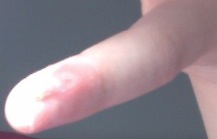Corn (pathology)

Editor-In-Chief: Prab R Tumpati, MD
Obesity, Sleep & Internal medicine
Founder, WikiMD Wellnesspedia &
W8MD medical weight loss NYC and sleep center NYC
| Corn | |
|---|---|

| |
| Synonyms | Clavus, heloma |
| Pronounce | N/A |
| Specialty | Dermatology |
| Symptoms | Thickened skin, pain |
| Complications | Infection, ulceration |
| Onset | Gradual |
| Duration | Long-term |
| Types | N/A |
| Causes | Pressure, friction |
| Risks | Tight shoes, abnormal gait |
| Diagnosis | Physical examination |
| Differential diagnosis | Callus, wart, foreign body |
| Prevention | Proper footwear, orthotics |
| Treatment | Paring, salicylic acid, pumice stone |
| Medication | Keratolytic agents |
| Prognosis | N/A |
| Frequency | Common |
| Deaths | N/A |

Corn (pathology) is a type of skin lesion that typically develops as a response to pressure or friction. They commonly occur on the feet, particularly on the soles, and can cause significant discomfort and pain.
Causes[edit]
Corns are caused by repeated pressure or friction on an area of skin. The most common cause is wearing shoes that do not fit properly. Tight shoes and high heels can compress areas of the foot. When the foot is also subjected to the pressure of walking or running, corns can develop on the bony or prominent areas of the foot. Other possible causes include walking without wearing socks, or wearing socks that do not fit properly.
Symptoms[edit]
The symptoms of a corn include a hard, thickened area of skin, pain or tenderness under the skin, and flaky, dry or waxy skin. Corns are usually about the size of a pea and can be either soft or hard. Soft corns are typically found between the toes, while hard corns are often found on the tops of the toes or on the outer side of the little toe.
Treatment[edit]
Treatment for corns usually involves avoiding the repetitive actions that caused them to develop. Wearing properly fitting shoes, using protective pads and other self-care measures can help alleviate the symptoms. In severe cases, surgical removal of the corn may be necessary.
Prevention[edit]
Prevention of corns primarily involves proper foot care and the use of well-fitted shoes. Shoes should be comfortable, with plenty of room for the toes to move, and socks should always be worn to reduce friction. Regularly moisturizing the feet can also help to prevent the skin from becoming dry and prone to corns.
See also[edit]
References[edit]
<references />
External links[edit]
Ad. Transform your life with W8MD's Budget GLP-1 injections from $75


W8MD offers a medical weight loss program to lose weight in Philadelphia. Our physician-supervised medical weight loss provides:
- Weight loss injections in NYC (generic and brand names):
- Zepbound / Mounjaro, Wegovy / Ozempic, Saxenda
- Most insurances accepted or discounted self-pay rates. We will obtain insurance prior authorizations if needed.
- Generic GLP1 weight loss injections from $75 for the starting dose.
- Also offer prescription weight loss medications including Phentermine, Qsymia, Diethylpropion, Contrave etc.
NYC weight loss doctor appointmentsNYC weight loss doctor appointments
Start your NYC weight loss journey today at our NYC medical weight loss and Philadelphia medical weight loss clinics.
- Call 718-946-5500 to lose weight in NYC or for medical weight loss in Philadelphia 215-676-2334.
- Tags:NYC medical weight loss, Philadelphia lose weight Zepbound NYC, Budget GLP1 weight loss injections, Wegovy Philadelphia, Wegovy NYC, Philadelphia medical weight loss, Brookly weight loss and Wegovy NYC
|
WikiMD's Wellness Encyclopedia |
| Let Food Be Thy Medicine Medicine Thy Food - Hippocrates |
Medical Disclaimer: WikiMD is not a substitute for professional medical advice. The information on WikiMD is provided as an information resource only, may be incorrect, outdated or misleading, and is not to be used or relied on for any diagnostic or treatment purposes. Please consult your health care provider before making any healthcare decisions or for guidance about a specific medical condition. WikiMD expressly disclaims responsibility, and shall have no liability, for any damages, loss, injury, or liability whatsoever suffered as a result of your reliance on the information contained in this site. By visiting this site you agree to the foregoing terms and conditions, which may from time to time be changed or supplemented by WikiMD. If you do not agree to the foregoing terms and conditions, you should not enter or use this site. See full disclaimer.
Credits:Most images are courtesy of Wikimedia commons, and templates, categories Wikipedia, licensed under CC BY SA or similar.
Translate this page: - East Asian
中文,
日本,
한국어,
South Asian
हिन्दी,
தமிழ்,
తెలుగు,
Urdu,
ಕನ್ನಡ,
Southeast Asian
Indonesian,
Vietnamese,
Thai,
မြန်မာဘာသာ,
বাংলা
European
español,
Deutsch,
français,
Greek,
português do Brasil,
polski,
română,
русский,
Nederlands,
norsk,
svenska,
suomi,
Italian
Middle Eastern & African
عربى,
Turkish,
Persian,
Hebrew,
Afrikaans,
isiZulu,
Kiswahili,
Other
Bulgarian,
Hungarian,
Czech,
Swedish,
മലയാളം,
मराठी,
ਪੰਜਾਬੀ,
ગુજરાતી,
Portuguese,
Ukrainian
